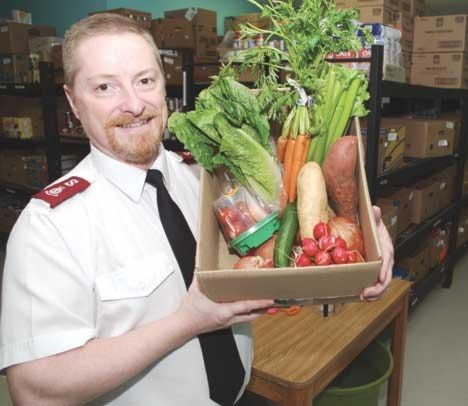It’s a quiet morning at the Community Food Bank on Redford Street.
The silence in the foodstore room is broken by the quiet shuffling steps of a volunteer, her white shopping bag making a crinkling sound as she fills it with cans of soup, a box of pasta, package of crackers and other goods before making her way out to a waiting patron.
There is one thing missing from the bag: fresh produce. All of it was given out to food bank patrons the day before. There are canned vegetables though, which make do in a pinch.
“We try, but we can’t offer fresh produce with every hamper,” Salvation Army Major Bruce MacKenzie said. “It’s a common dilemma faced by food banks.”
MacKenzie has long noticed an over-representation of starchy foods and carbs in hampers the food bank offers.
In Port Alberni, the Salvation Army operates the Community Food Bank. The service assists upwards of 60 families per week, MacKenzie said.
The food bank receives donations from local residents, businesses and aboriginal groups, and it also receives goods from most Alberni Valley stores through food reclamations.
Those in need are able to access the service once every 30 days for a hamper, which consists of dry goods, pasta, canned meat, soups and canned veggies.
“Those are the classic non-perishables that are the staples of food banks,” MacKenzie said. “They aren’t expensive and they have a long shelf life.”
Nutrition value is compromised with added shelf life and a balance of fresh foods needs to be added to the equation, MacKenzie said.
According to the Public Health Agency of Canada, almost 2.4 million Canadians were living with diabetes in 2009. The disease was more common among males than females.
And the Canadian Diabetes Association estimates that 20 per cent of aboriginal people in Canada live with diabetes. A diet rich in starchy carbs is among the risk factors in developing the disease, both agencies note.
“The question I’ve been asking is: how can we bolster the nutritional value of hampers for people who rely on the food bank,” MacKenzie said.
The issue was in MacKenzie’s mind when he came into contact with the Integrated Health Network in Port Alberni.
The IHN is a branch of the Vancouver Island Health Authority (VIHA), and employs a registered nurse, two dietitians and a social worker that work with doctors, patients and several support services.
MacKenzie has had conceptual discussions with the IHN about the idea but the talks have remained just that, he said.
“I’d like to see locally grown good used but what that means and how it can be done remains to be seen,” MacKenzie said.
There are logistical issues to consider, such as funding and storage. A walk-in cooler is a significant investment, as would be the corresponding increase in hydro costs.
Across town at the Bread of Life, fruits and vegetables are staples. “We serve them with every meal,” director Cindy Sjoholm said.
The organization serves one meal a day, five days a week, to between 60–80 patrons.
BOL works with local businesses to get the produce, which it stores at its Third Avenue location. “We used to be a restaurant so we already have a walk-in cooler,” Sjoholm said.
MacKenzie is convinced that the health and social benefits of adding fresh produce to hampers warrant some action.
“Salvation means in part saving lives,” MacKenzie said. “This would be a step in the right direction,” he said.
reporter@albernivalleynews.com
